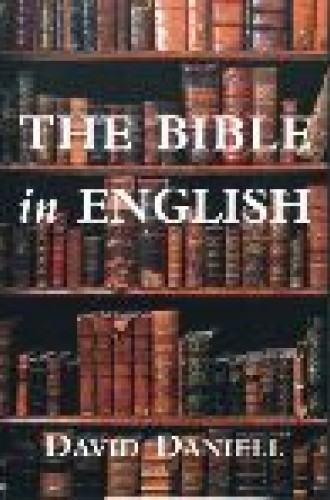The Bible in English: Its History and Influence
Sometimes you can tell a book by its cover. David Daniell’s tome features five shelves crowded with leather-bound Bibles on the front cover and a woodcut of William Tyndale’s martyrdom on the back. The front cover indicates the scope of Daniell’s subject—the 3,000 translations and many more editions that constitute “the Bible in English.” The woodcut delimits his perspective—the formative role played by Tyndale and other Protestant translators in shaping Anglo-American life. As Daniell puts it, “This book is about how important the Bible in English has been in the life of Britain and North America”—an importance obscured in recent years, he says, by ignorance of the Bible and hostility toward its message and significance. Daniell takes aim at both.
Ignorance is countered by a detailed survey of English Bibles, from the tenth-century Lindisfarne Gospels to the New International Version, with particular attention to the work of the 16th- and 17th-century translators. Tyndale is the presiding genius of this narrative, both as muse and brilliant exemplar, the touchstone for earlier as well as subsequent translations. Stories such as those of Anglo-Saxon Alfred, the anonymous Genevan translators and Charles Thomson, the first American to translate the whole Bible, are told with economy and verve. Daniell sets biography within the context of political and religious tensions, stirs in bibliographic descriptions, annotated passages from the texts, personal commentary and nearly 50 carefully selected illustrations to give us a good feel for the thousand-year history of the book. So much for ignorance.
Hostility is countered by a sustained critique of “revisionist” historians, such as Eamon Duffy, who see the Reformation as a “cultural disaster” and a cold-hearted, elitist attempt to tear the English people away from the beloved rituals of medieval Christianity. For Daniell, the English Bible of the Reformation, shaped largely by Tyndale’s masterful command of the vernacular, was from the first the people’s book, offering a “true revolution” that released ordinary men and women from the oppression of Latin masses and religious superstition and opened up English culture to literary creativity, scientific exploration and political freedom. This focused Protestant perspective defines the book. Daniell insists, for instance, that the 15th-century ban against the vernacular scriptures made “liberty of religious thought or high creativity impossible” and claims that “liberation from the threat of charges of heresy,” as well as the plain style forged by Tyndale and other Reformation writers, “allowed the new power of imagination and inventiveness that were grasped by the poets.”
Son of a nonconformist minister and himself a Shakespearean scholar who came late to his love of Tyndale, Daniell is at his best as a reader of texts. He takes time to compare translations in some detail, helping us hear and weigh the relative merits of word choice and syntax. When he quotes from a modern translation Elijah’s challenge to the Israelites, “How long do you mean to hobble first on one leg and then on the other?” and sets it against Tyndale’s epic terseness, “Why halt ye between two opinions?” we hear the lameness of the first account and join Daniell’s lament for the loss of vigorous language and of theology in many contemporary versions. When he teases out the significance of the King James Version’s neglected preface or rehabilitates the Geneva Bible’s marginal comments, countering their stereotypical “Calvinist” reputation, we reread these paratextual materials with new eyes.
Indeed, Daniell’s thesis that the English Bible has been important for the life of Britain and North America is worked out entirely through textual evidence—by demonstrating the sheer number and variety of Bibles that continue to circulate and by examining the influence of biblical typology on imaginative literature, from paraphrases to Dryden’s political satires to slave poetry.
Daniell’s historical scholarship is encyclopedic rather than original. He pulls together the work of many scholars—his footnotes are worth reading in their own right—but he is also at the mercy of his secondary sources. As a result, some details are muddled, as in the baffling omission of Mary Sidney Herbert as a primary contributor to the metrical psalm tradition. The genesis of this book in lectures and Daniell’s previous work on Tyndale results in some redundancy as well as factual discrepancies, but does provide a boon for readers who can pick up individual chapters as self-contained units.
There is, moreover, the pleasure of Daniell’s tart commentary and dry humor, as in this description of the mystery plays: “With its long paragraphs of lightly rhyming verse, the English can sound stilted, ponderous (and even, dare one say, boring: heard on a cold wet evening in a dripping garden in front of an ancient damp wall, God can be felt to drone on, somewhat).” Finally, if Daniell’s fervor for all things Protestant, English and Tyndalian seems a bit tendentious at times, we can admire—and benefit from—the fierce devotion of such a bibliophile, a true lover of books and the Book.





